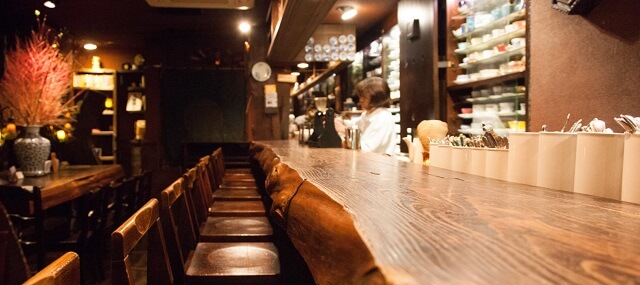
Every neighborhood in Tokyo has its own flavor, an identity all its own comprising the people who live there, the people who pass through, and the kinds of companies, shops and schools that have taken root. Smaller areas might be likened to a simple but hearty cup of tea, whereas larger centers tend to smack of the deeper, more complex brews.
-
Shinjuku is certainly among the latter. JR Shinjuku, a hub on the circular Yamanote Line, is Japan’s busiest station and indeed among the busiest in the world. More than a million people pass through it each day, and Shinjuku itself is accordingly a massive snarl of activity.
![Café Bon]()
Café Bon
Spend even a few hours here shopping or seeing the sights and you may find yourself in need of a bit of rest and respite. For this, nothing is better than a quiet cup of high-grade coffee at Cafe Bon, an establishment that takes its name not from the French, but rather from a Chinese symbol meaning “ordinary,” which, thankfully, it is anything but.
![Café Bon]()
Café Bon
![]()
![]()
As with so many things in Tokyo, Cafe Bon is a hidden gem. A simple sign on the street opposite the station leads below ground via a flight of steep stairs. Inside it’s another world, hushed and made almost entirely of natural wood.
As your eyes adjust to the understated lighting, one of the first things you’ll notice is a wall lined with conspicuously lit tea and coffee cups that are the pride and joy of Katsuya Taira.![Café Bon]()
Café Bon
Taira is a man who understands nuance. Before building this little cove of quiet 40 years ago he traveled to Europe to study its best cafes, soaking up not only the secrets of perfect percolation, but also those elements that are harder to describe, little details of construction and decor that make such places into more than the sum of their parts. And indeed it’s difficult to say which aspect, between the coffee and cakes and the atmosphere, keeps people coming back.
![Café Bon]()
Café Bon
![]()
![]()
The coffee, roasted and ground on site, is served in the exquisite cups and saucers that line the wall, an ongoing collection. No two are alike and they hail from all over the world, including Europe and Japan. Some are more than a century old.
Taira knows each cup well and can tell the stories attached to many of them in Japanese. (He’s also very welcoming to guests from abroad, and is happy to speak basic English.) He thinks of the cups as cornerstones of conversation, starting points that can lead anywhere. He claims no special method for assigning cups to customers, preferring to leave it up to spontaneous creative whim.![Café Bon]()
Café Bon
-
![Café Bon]()
Café Bon
![]()
![]()
The cafe’s other key feature is a massive slab of bar that runs its length, thick as your fist and the better part of a meter wide. The wood was specially selected from Mrs. Taira’s hometown in Chiba Prefecture and brought to the cafe during construction, the intent being to install it as-is and intact. Unfortunately the dimensions of the stairs and entranceway made this impossible, so it had to be cut into several sections and reconstituted below, but the work is seamless and the effect no less diminished. It emanates a natural feeling that extends to the cafe’s four corners. Even the cakes, made from scratch by Mrs. Taira, use only natural butter and never margarine, she says.
![Café Bon]()
Café Bon
![]()
Tea is also available for those who shun coffee, along with a variety of other liquid fare. The prices are perhaps more than might be paid in other establishments that blast terrible music through tinny speakers, but the ambiance at Cafe Bon is more than worth the price. As a game, see if you can guess the location of the lavatory, which is hidden in true haunted-mansion style.
—–
Address: Tokyo, Shinjuku-ku, 3-23-1 Shinjuku, right beside Camera Alps
Hours: 12:30 – 23:50
Phone: 03-3341-0179- 自家焙煎珈琲 凡
-
-
- 東京都新宿区新宿3-23-1 都里ビルB1F
-
-
-
- 03-3341-0179
-
View All




















